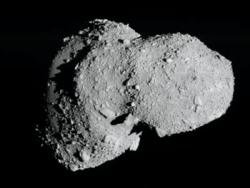This article is more than 1 year old
Asteroid Itokawa just a big lump of rubble
Not solid, as previously thought
 Asteroid Itokawa - subject of a 2005 visit by Japan's Hayabusa probe - is nothing more than lump of rubble, new studies have shown.
Asteroid Itokawa - subject of a 2005 visit by Japan's Hayabusa probe - is nothing more than lump of rubble, new studies have shown.
The fact that the 535-metre asteroid is not solid as previously assumed has come as a bit of a surprise to those examining the Hayabusa data, New Scientist reports. Photographs reveal the body's surface "littered with boulders and gravel" which suggest it's comprised of the debris of an earlier asteroid collision.
Planetary scientist Erik Asphaug, of the University of California in Santa Cruz, said: "Five years ago, we thought that we would see a big chunk of monolithic rock, that something so small doesn't have the ability to hold onto any pieces. Everything we suspected about it turned out to be wrong."
Other evidence backs up the photographs: Hayabusa measurements of Itokawa's gravitational field, with its size factored in, reveal it's 40 per cent empty space. Asphaug describes this porosity as "astonishing", explaining: "It's very hard to get porosities greater than that. You've got to start balancing things delicately, like you were building a house of cards. The only way to do it is to gently pack the stuff together."
And therein lies the mystery, NS notes. Given its age, Itokawa should have become progressively less porous as repeated impacts "tamped down" the loose material. There's little evidence of impact craters on the surface, but that's believed to be because they're filled by gravel which is shaken down into the crater by post-impact vibration.
Hayabusa, meanwhile, is en route home - albeit with a three year delay. It successfully landed on Itokawa but whether or not it collected the intended samples remains doubtful. There's a report on its current status down at the Japan Aerospace Exploration Agency website. ®
